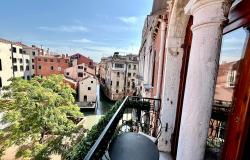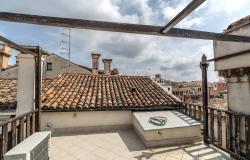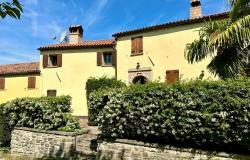Throughout Italy, it seems, grapes grow almost everywhere. On the wine hills that extend around Lake Garda, as well as on the flat plains around Verona and into the steeper balcony of vine-covered hills of the Valpolicella and Soave, there is a veritable sea of vines, as far as the eye can see.
This is truly one of Italy’s great wine regions. Yet it rarely attracts the attention of more famous areas such as Tuscany and Piedmont. I wonder why? Perhaps it is because in spite in intensive viticulture, the area offers so many other attractions to the visitor, not least the charms of Lake Garda, a hugely popular tourist mecca, and of course Verona itself, with its centro storico and its famous opera season in the Roman arena.
Or could it be that, in times past as even now, the area has been, and continues to be, perceived mainly as the source of vast quantities of plentiful and inexpensive jug wines. Today there is nothing neutral or bland or mass-produced about the best wines that have emerged from this stunningly beautiful wine zone. So I urge you to look again at familiar names and be prepared to be very nicely surprised.
Lake Garda wines
The gentle moraine hills that rise from the banks of Lake Garda are about as idyllic a wine country as you will ever find. The vines thrive on grassy slopes and terraces, in many cases still trained on old-fashioned pergole to spread dappled ‘ceilings’ of foliage, and creating grassy shaded corridors in which to stretch out after a long midday meal or one glass of wine too many.
On the vineyards across the eastern side of the lake, by late summer bunches of Corvina, Rondinella, Molinara and Negrara grapes hang down invitingly from the dappled pergole, virtually begging to be picked. These grapes are the source of Bardolino, Bardolino Classico (from the central heart of the district), and Chiaretto and Chiaretto Classico, mainly simple, delightful wines that are seemingly in total harmony with the region itself: fresh, fragrant, uncomplicated wines that simply cry out to be drunk.
Bardolino novello, Italy’s answer to Beaujolais nouveau and the country’s first DOC novellowine, is the very essence of wine at its freshest and most basic, deliciously grapey, fragrant and quaffable.
Straight Bardolino and Bardolino Classico, though more serious than novello,are still wines to be enjoyed not after lengthy periods of ageing but while still fresh and fragrant. That is not to say that Bardolinois one-dimensional: the best wines are indeed capable of complexity but on the whole it’s greatest asset is its delicacy, perfume and vivacity. Chiaretto, meanwhile, is a pale red or dark pink version of Bardolino, a firm, full-bodied rosato that is an ideal summer wine, especially to enjoy beside the lake with fried fish or risotti. Two noteworthy white wines that deserve to be better known also come from vineyards that extend around the shores of Lake Garda. Bianco di Custoza is produced from an intriguing mixture of grape varieties that may include Garganega, Tocai Friulano, Riesling Italico, Chardonnay and Trebbiano, cultivated on wine hills to the south of the lake. This blend of grapes can result in deliciously fruity wines that are the favourite tipple in the bars and drinking holes of Verona. Here you don’t ask for a ‘vino bianco’, simply a ‘Custoza’.
Two noteworthy white wines that deserve to be better known also come from vineyards that extend around the shores of Lake Garda. Bianco di Custoza is produced from an intriguing mixture of grape varieties that may include Garganega, Tocai Friulano, Riesling Italico, Chardonnay and Trebbiano, cultivated on wine hills to the south of the lake. This blend of grapes can result in deliciously fruity wines that are the favourite tipple in the bars and drinking holes of Verona. Here you don’t ask for a ‘vino bianco’, simply a ‘Custoza’.
Lugana, produced primarily from Trebbiano di Lugana grapes grown on the gentle glacial hills along the southern and western flanks of the lake, mainly in the region of Lombardy, can be a wine of character and personality, at best with a deep and concentrated flinty, mineral style that makes it an excellent accompaniment to food.
La Valpolicella, the classic heartland
The vineyards of Valpolicella begin virtually at the outskirts of Verona with the finest extending to the north over hills above three steep valleys, Fumane, Marano and Negrar. Though the range of grapes cultivated is the same as those found in the gentler wine country of adjacent Bardolino, here, on harsher granite and calcareous wine hills planted at higher altitude, sometimes on historic dry-stone terraces that maintain the integrity of the terrain, the result is wines that have considerably more structure, elegance and even a capacity to age.
Sometimes superior wines come from single vineyards (indicated as ‘vigneto’ or ‘cru’ on the bottle). What is important to distinguish is wines from the classic heartland produced from selected grapes by the area’s most serious winemakers, as opposed to industrially produced wines made from prolific and indifferent grapes grown on the flat pianura.
Wines from semi-dried grapes
 In addition to straight Valpolicella produced from fresh grapes, two unique Veronese speciality wines are also produced here from semi-dried grapes: Recioto della Valpolicella, a sweet red dessert wine, and Amarone della Valpolicella, a big, powerful dry red wine. The name Recioto comes from ‘recce’ which in dialect means ear (Italian, orecchio) signifying the top shoulders of the grape bunch, which have received greater exposure and are thus richer in extract, concentration and sugar. This part of the best bunches is harvested early and then laid out on large wicker trays in great airy lofts high in the wine hills to dry for a period of some months (usually until after Christmas).
In addition to straight Valpolicella produced from fresh grapes, two unique Veronese speciality wines are also produced here from semi-dried grapes: Recioto della Valpolicella, a sweet red dessert wine, and Amarone della Valpolicella, a big, powerful dry red wine. The name Recioto comes from ‘recce’ which in dialect means ear (Italian, orecchio) signifying the top shoulders of the grape bunch, which have received greater exposure and are thus richer in extract, concentration and sugar. This part of the best bunches is harvested early and then laid out on large wicker trays in great airy lofts high in the wine hills to dry for a period of some months (usually until after Christmas).
This is the appassimento, during which the grapes become semi-raisins, losing liquid but gaining in concentration of sugar, flavour and intensity. Once the drying process is deemed complete, the uve appassite are very lightly crushed and placed in fermentation vats.
Winter temperatures are low, so fermentation proceeds slowly; gradually the sugars are transformed into alcohol. For Recioto, the fermentation usually stops of its own accord leaving behind a light residual sweetness; Amarone, by contrast, ferments out to dryness to result in a massive wine with alcohol levels that can reach 15 degrees or more.
The crushed, wine-drenched, semi-dried grapes, after fermentation, are not wasted either. They are drained and then straight Valpolicella is poured over them. This procedure provokes a light secondary fermentation that both adds a degree or so of alcohol as well as the unique, rich, raisiny aromas and texture of dried grapes. This style of Valpolicella is known as ‘ripasso’ and most of the serious producers make such wines which are most certainly worth trying.
Soave, an undiscovered medieval town awash with wine
 Like Valpolicella, Soave is one of the best known names in Italian wine. Also like Valpolicella, the best Soave, made from selected grapes grown within its classic heartland, bears little or no resemblance to the vast quantities of neutral and indifferent bulk wines that bear the name.
Like Valpolicella, Soave is one of the best known names in Italian wine. Also like Valpolicella, the best Soave, made from selected grapes grown within its classic heartland, bears little or no resemblance to the vast quantities of neutral and indifferent bulk wines that bear the name.
The town itself remains mainly undiscovered and is the best place to come to sample and taste at the source.
Indeed for those who have never encountered Soave from one of the zone’s top producers, the wine can be a revelation: never overly up-front yet concentrated and full of flavour and personality with over-ripe honeyed flavours that can be intriguing and long-lasting. Soave is made primarily or exclusively from Garganega grapes, sometimes with the addition of Trebbiano.
Usually the wine is fermented in stainless steel and is released to be enjoyed young. Some producers, how- ever, feel the wine can benefit from ageing in new French oak to add greater body and depth of flavour. Furthermore, a rare dessert wine made from semi-dried grapes is also produced, Recioto di Soave. This is a very special, unique wine that must be sampled if you have the opportunity.
Soave itself is a still mainly undiscovered and wholly charming little medieval wine town. Come here to visit the Scaligero castle and to sample wines in the town’s central enoteca.
Innovation alongside tradition
As elsewhere in Italy, the new IGT (indicazione geografica tipica) regulations have encouraged winemakers to experiment with new grape varieties, blends, and ageing (usually in new French oak). Chardonnay and Sauvignon, Merlot and Cabernet all make occasional cameo appearances while some producers are seeking to revalue traditional and indigenous varieties such as Oseleta to result in a new breed of super-Venetian wines.













